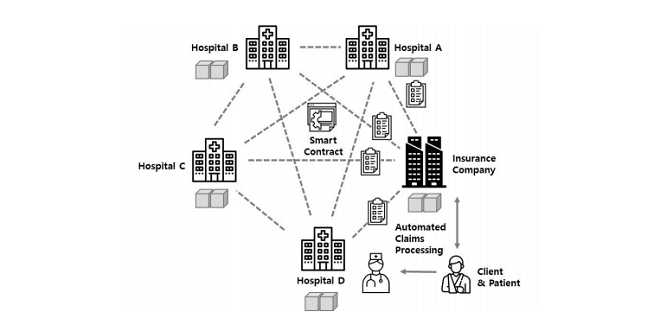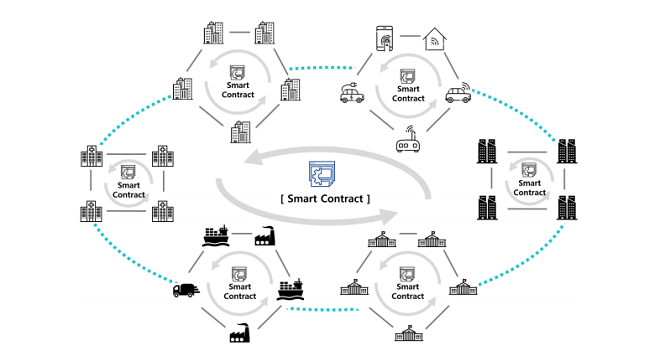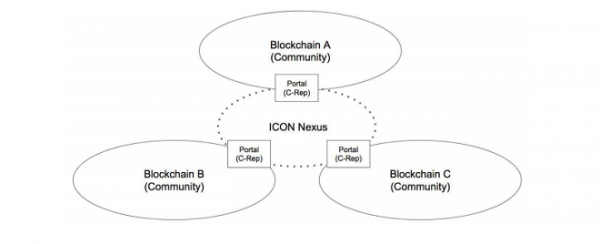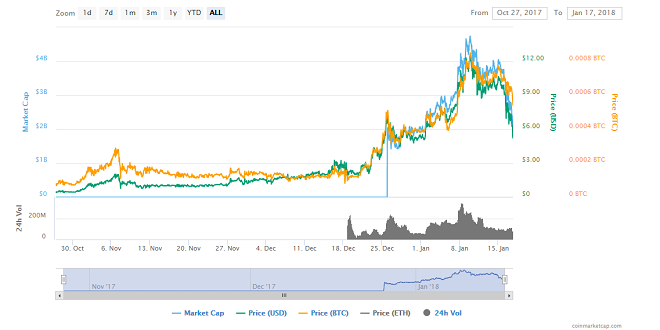It is imperative to see cryptocurrencies not as money, but as tools – tools that facilitate certain use cases which are bolstered by the natural advantages of the blockchain. Cryptocurrencies are programmable protocols that can be customized to suit any number of needs. This is the brilliance behind a platform like Ethereum, which many other coins have taken inspiration from.
Given the ability of blockchain to work across a variety of industries, it would be logical to have a platform on which we could link data and payment services between these different industries. Rather than having to use cash or traditional digital banking, which can be cumbersome, to facilitate operations between, let’s say, the medical and insurance industries, we could have the blockchain do it for us on a single platform.
It turns out there are companies thinking about ways of linking micro-communities within the larger economy.
What is ICON?
ICON believes that the world has already progressed into being divided not by nationalities, but by communities. Hospitals, commerce, charities, educational institutions, banks, insurance providers – these are all communities who rely on each other to operate. These are systems of service providers who would perform better if they had access to the data security and services provided by related industries.
ICON was founded by the Dayli Financial Group, a $4 billion organization, in 2016 and many of its team members have worked for the company in the past. The Dayli Group also owns the Korean exchange Coinone.
ICON does not dally with communicating its aim to “hyperconnect” the world. Right off the bat, the abstract in their whitepaper informs the reader of ICON’s attempts to overcome the challenges of our data-heavy world through the power of blockchains.
The company likes to use the medical and insurance sectors as examples of the practical value of ICON. When an individual visits the hospital for medical services and wishes for the treatment to be covered by his insurance, a hospital on the ICON network can send the patient’s details associated with the blockchain ID to the insurance provider, who is also on the ICON network. This transaction will occur using ICON tokens, ICX.

For all its pizazz, ICON is primarily a decentralized applications platform with the additional feature of interlinking various blockchains. It is a direct competitor to coins like Ethereum and NEO, though it has a more inclusive nature.
Before we get into the characteristics that set it apart from the aforementioned platforms, let’s take a look at how the platform works.
How Does ICON Work?
ICON’s platform is best thought of as a blockchain of blockchains. Independently-governed blockchains, that can function by their own rules, can operate on the ICON platform to work with each other. While in a Nexus (explained shortly), they will have to abide by certain rules, but they will still have governance over their individual blockchains. Think of them as independent states, with their own rules, working at a international level when they must cooperate with each other.
These independent blockchains connect to each other through the Nexus and have equal voting rights. The Decentralized Exchange that ICON offers will let them trade with each other through the common token, ICX. Every node has equal rights and have a say in the adjustment of ICX transaction fees. These Community Representatives (“C-Reps”) are compensated for maintaining their community’s blockchain with ICX tokens.

To keep it simple, the Nexus and loopchain are the space where different ledgers can talk, and the tokens are the mics with which they can communicate.
This system gives ICON the potential to become the largest and most scalable blockchain in the world. It is a way of letting blockchains do what they want, while also leveraging the capabilities of other blockchains in one unified platform. It is a solution to a higher level problem.
What Makes ICON Unique?
If a cryptocurrency is to succeed, it will need robust proprietary technical architecture that can live up to its hype. ICON does indeed have a lot of interesting technical aspects that make sense given its intentions.
DAVinCI Artificial Intelligence
ICON uses AI for its distribution policies and to ensure that nodes in the network are fairly rewarded. The DAVinCI AI algorithm was developed by Dayli Intelligence. AI and blockchain are two technologies perfectly suited for each other, playing off each other very well. They plan to teach the AI to learn from several variables to achieve full decentralization.
DEX (Decentralized Exchange)
There are pros and cons to both centralized and decentralized exchanges. The former is more convenient but less secure, and the latter, vice versa.
ICON is offering its own Decentralized Exchange (DEX) that will link independently-governed blockchains, using the ICX token. The exchange rate is determined through the Bancor Protocol. The details of this protocol are available in ICON’s whitepaper, which is a very educating read.
Loopchain
The loopchain, which can connect various blockchains to each other, is arguably ICON’s most noteworthy feature. This is what gives it a very authentic practical application that distinguishes it from other coins. The loopchain is an enterprise blockchain, with smart contracts compatibility, that can be customized according to operational and needs and linked with other ledger networks.
Loop Fault Tolerance (LFT)
ICON has developed its own consensus algorithm, called Loop Fault Tolerance, that supports Byzantine Fault Tolerance. LFT aims to improve performance by consolidating messages across the network.
This method uses a technique called “spinning” to make selecting the primary node simpler. It reduces the number of nodes involved in consensus, thereby making the network more efficient and scalable.
Nexus and ICON Republic
We have mentioned that ICON allows a variety of blockchain-based independent communities connect to each other through its platform. This is done through the Nexus and ICON Republic.
A Nexus is a collection of blockchain communities that can be connected to each other through C-Rep portals. One Nexus can be connected to others, allowing for great scaling and interconnectivity. Imagine one set of communities, like hospitals and insurance agencies, connecting to another, like universities and employers.

The Nexus/C-Rep portal model is similar to the internet’s network of networks. A Blockchain Transmission Protocol is what facilitates transactions between various independent blockchains that are connected to the Nexus via portals. This is where the idea of “hyperconnectivity” comes from.
Each blockchain will represent itself on the Nexus through its portal. The ICX tokens can be used by the blockchains to transfer values between various blockchains. ICON’s blockchain of blockchains allows different blockchains to execute transactions and exchange values.
Independent Governance
Every blockchain connected to the Nexus can operate independently and governs itself. ICON calls the system an indirect democracy, with every blockchain having an equal level of representation.
The Nexus will feature representation channels that allow involved parties to cast votes and propose policies. The representation channel is composed of nodes that participate in the C-Rep. This channel will let participants decide the addition or removal of nodes, adjust ICX transaction fees and discuss the voting rights of nodes in various channels. They compare the voting process to the Electoral College System.
Nexus Public Channel
The public channel on the Nexus is open to all. This will let people participate in ICX transactions, and create and use decentralized applications like Ethereum. However, unlike Ethereum, users will have to download and install these applications from the dapp store first.
No Mining
ICON tokens cannot be mined. Instead, new tokens will be issued after an annual discussion among C-Rep members.
The ICON Team
When you’re gauging the potential for success for a particular blockchain project, the team running the project is a key factor. ICON’s team is expansive and impressive, with over 50 team members across at least 3 departments: blockchain, AI and marketing, design and security.
Hailing from South Korea, one of Asia’s hottest cryptocurrency hubs, the team comprises individuals with expertise in blockchain technology, artificial intelligence, financial services, business and various software engineering sub-specialties.
Sunghwan Kim is the head of the AI department. He has over 10 years experience in data analysis and development. His current interests lie in natural language processing and data engineering.
Gail Kang leads the marketing department. She has over 14 years of experience in branding and marketing in various industries, including entertainment, finance and fashion.
ICON is advised by 8 distinguished individuals. One of the most prominent advisors is Don Tapscott, who co-authored the book Blockchain Revolution and opened the Blockchain Research Institute. Jason Best, a crowdfunding mogul who is the co-founder of Crowdfund Capital Advisors, also advises the team.
Yiseul Cho, who has experience working for Facebook and has run her own R&D blockchain lab, is another notable member. The other advisors are Ismail Malik, Simon Seojoon Kim, Eddy Travia, Jehan Chu and Paul Veradittakit.
The ICON foundation’s council members include KJ Eee, JH Kim, Jay Kim, Hoon Lee, Min Kim and Guido Schmitz-Krummacher. Their expertise lies in artificial intelligence, blockchain, information security, financial analysis and entrepreneurship.
ICON Roadmap
ICON continues to make a good impression with its clearly communicated roadmap, explained from both a business and technical perspective. This sort of communication is exactly what a blockchain project must strive for, as it indicates genuine transparency and a desire to reach out to the community.
In Q3 2017, ICON open sourced their loopchain network and partnered with a major bank. While there’s no information about the specific bank, we do know they have partnerships with the Dayli Financial Group, SBI Ripple Asia and Woori Bank.
In Q4 2017, they conducted their ICO, had their token listed on exchanges and launched pilot services to 3 universities, as well as insurance services and financial investment consortiums.
From the technical point of view, ICON launched a decentralized exchange, created wallets for the web, iOS and Android, and launched the Nexus Mainnet.
Q1 2018 will see an expansion of their services to include more blockchain networks. A second developers meeting will be also held in this period. The expansion will focus on establishing compatibility for major cryptocurrencies in the decentralized exchange and developing partnerships with more blockchain networks. Technical developments will include an AI advisor launch and the opening of a public channel.
The next major developments are scheduled for Q3 2018. ICON will expand their U-coin to include 10 participating universities. They will also launch the second service of the financial investment consortium. Lastly, the third developers meetup will be organized.
ICON’s Market Performance
Ranking 17 on Coinmarketcap with a total market cap of just over $3 billion (information correct as of time of writing), ICON’s value almost consistently increased over 2017.
In the recent chaotic episode that has been taking place in the markets, its value has dropped from its market cap peak of $4.6 billion, but the forecast is good for the coin. The current value of the coin is $7.98 (as of January 19, 2018).
The maximum supply of ICON is 400,230,000 ICX.

ICON conducted their token sale from September to October 2017, where they successfully met their fundraising goal of 150,000 ETH. 50% of the tokens were available to the public for sale. 16% was allocated to the project’s reserves, 10% was set aside for the team, advisors and early contributors, another 10% for community groups and strategy partners, and the final 14% for the foundation.
The funds raised in the ICO are being used as follows: 20% for the company’s tech, 12% for operation expenses, 8% for marketing expenses, 15% for business development, 10% for strategic partnerships and the remaining for reserves.
Competitors, Challenges and Potential
As a smart contracts solution, ICON’s primary challengers are Ethereum and NEO, two of the biggest names in the smart contracts space. That said, there are several differences between ICON and these coins.
Both Ethereum and NEO have strong business partnerships and usable scenarios. The latter is working with the Chinese government to digitize the economy and the former on what is essentially a global scale. However, they do not possess the interoperability that ICON offers. ICON may dominate given its focus on blockchain inclusion, not competition.
On the other hand, ICON’s success will depend on other blockchains working on their platform. Who is to say with any assurance that the different communities will come together on the Nexus? There will have to be an aggressive marketing and business strategy to achieve this. Fortunately, ICON does have a strong list of partnerships.
ICON has already partnered with 28 financial firms in Korea. They also have the support of Korea’s largest bank, Woori. Their loopchain network is also used by top-tier Korean security firms, universities and insurance companies.
Dayli Financial Groups owns the exchange Coinone. The DEX and wallet features is a useful additional feature that makes working with different cryptocurrencies easier.
How to Purchase and Store ICX
Buying ICON tokens is a simple enough matter, though you won’t be able to purchase the tokens with fiat currency. That means you’ll have to trade Ether or Bitcoins for ICX.
Binance is one of the most popular exchanges to buy ICX, accounting for most of the transactions. When you’ve purchased ETH or BTC on these exchanges, or have it sent from another wallet, simply trade it for ICX.
Final Thoughts
ICON’s attempt to connect all the blockchains of the world into one single unified, organic system that allows inter-blockchain communication is not just admirable, but logical.
In a world where different industries are likely to be supported by different coins and platforms tailored to that particular use case, the need for a platform that allows these various coins to interact with each other is paramount. ICON is a sort of economy that supports micro-economies.
This is the kind of long-term vision that cryptocurrencies need. ICON is addressing an inevitable problem in the cryptocurrency market – how do different blockchains work with each other?
As no single blockchain will be comprehensive in terms of use cases, it will be necessary for some system to exist that permits interoperability. For this reason, and for the fact that it has a strong list of business partnerships, ICON could very well skyrocket this year and the next.
